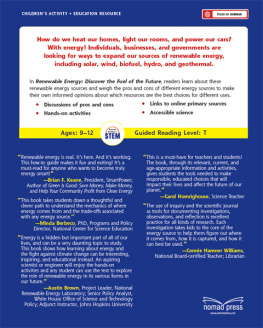ABOUT THE AUTHOR
Kenneth P. Green , a biologist and environmental scientist by training, has studied public policy involving risk, regulation, and the environment for more than sixteen years at public policy research institutions across North America. He is the author of numerous policy studies, magazine articles, newspaper columns, encyclopedia and book chapters, and a textbook for middle school students entitled Global Warming: Understanding the Debate (Enslow Publishers, 2002). Mr. Green has testified before regulatory and legislative bodies at both state and federal levels, and speaks frequently to the public and the media. He has twice served as an expert reviewer for the United Nations Intergovernmental Panel on Climate Change.
CONCLUSION
We have surveyed some critical concepts needed to understand energy, its role in our society, its impacts on our lifestyle, its impact on the environment, and the importance of affordability and reliability. We have also discussed the meaning of energy independence, and we have looked at the potential for unintended consequences of even the best-intended interventions into our vast energy systems.
It is not my desire to tell anyone how to think about energy. Nobody can reasonably do that for another person. Rather, my hope is that this book will inspire readers to study energy more deeply and to question facile claims of simple solutions to complex energy-related challenges, regardless of who makes them. And most important, I hope this book will help readers formulate their own set of questions, think through their own values as they apply them to questions of energy policy, and think through what they believe is the best energy policy that our country might adopt.
ONLINE RESOURCES
CHAPTER 1
Mark Derr, Of Tubers, Fire, and Human Evolution, http://www.nytimes.com/2001/01/16/science/of-tubers-fire-and-human-evolution.html?pagewanted=2.
Science Daily , Light My Fire: Cooking as a Key to Human Evolution, http://www.sciencedaily.com/releases/1999/08/990810064914.htm.
Wikipedia , Control of Fire by Early Humans. http://en.wikipedia.org/wiki/Control_of_fire_by_early_humans.
CHAPTER 2
Kenneth P. Green and Aparna Mathur, Indirect Energy and Your Wallet (Washington, DC: American Enterprise Institute, 2008), http://www.aei.org/outlook/100017.
Kenneth P. Green and Aparna Mathur, Measuring and Reducing Americans Indirect Energy Use (Washington, DC: American Enterprise Institute, 2008), http://www.aei.org/outlook/29020.
CHAPTER 3
Renewable Energy Research Laboratory, University of Massachusetts at Amherst, http://www.ceere.org/rerl/about_wind/RERL_Fact_Sheet_2a_Capacity_Factor.pdf.
United States Association of Energy Economics, http://dialogue.usaee.org/index.php?option=com_content&view=article&id=95&Itemid=113.
Wikipedia , Capacity Factor and Renewable Energy, http://en.wikipedia.org/wiki/Capacity_factor#Capacity_factor_and_renewable_energy.
CHAPTER 4
Jesse H. Ausubel, The Liberation of the Environment, Daedalus (Summer 1996), http://phe.rockefeller.edu/Daedalus/Liberation/.
John Tierney, Use Energy, Get Rich, and Save the Planet, New York Times , April 20, 2009, http://www.nytimes.com/2009/04/21/science/earth/21tier.html?_r=1.
CHAPTER 5
New World Encyclopedia , Hydroelectricity, http://www.newworldencyclopedia.org/entry/Hydroelectricity#Oldest_hydroelectric_power_stations.
Wikipedia , Momentum, http://en.wikipedia.org/wiki/Momentum.
CHAPTER 6
Robert Bryce.com (www.robertbryce.com) has many articles about energy, including many on energy independence and security.
CHAPTER 7
Kenneth P. Green, Ethanol and the Environment (Washington, DC: American Enterprise Institute, 2008), http://www.aei.org/outlook/28396.
ENDNOTES
1 Daniel B. Botkin, Energy and Civilization, available at http://www.danielbbotkin.com/2007/03/19/energy-and-civilization/.
2 Nathanial Gronewold, One-Quarter of Worlds Population Lacks Electricity, Scientific American , November 24, 2009, available at http://www.scientificamerican.com/article.cfm?id=electricity-gap-developing-countries-energy-wood-charcoal.
3 Ibid.
4 Quoted in Richard Wrangham, Catching Fire: How Cooking Made Us Human (Philadelphia: Basic Books, 2009), 1.
5 Wrangham, Catching Fire .
6 Ibid., 102.
7 Frances D. Burton, Fire: The Spark That Ignited Human Evolution (Albuquerque: University of New Mexico Press, 2009).
8 U.S. Energy Information Administration, 2005 Residential Energy Consumption SurveyDetailed Tables, available at http://www.eia.doe.gov/emeu/recs/recs2005/c&e/detailed_tables2005c&e.html (from http://www.eia.doe.gov/emeu/recs/recs2005/c&e/detailed_tables2005c&e.html, with per-household calculations by author).
9 Mark Cooper, The Impact of Rising Prices on Household Gasoline Expenditures, Consumer Federation of America, September 2005, available at http://www.consumerfed.org/elements/www.consumerfed.org/file/energy/CFA_REPORT_The_Impact_of_Rising_Prices_on_Household%20Gasoline_Expenditures.pdf.
10 Stephen Budiansky, Math Lessons for Locavores, New York Times , August 19, 2010, available at http://www.nytimes.com/2010/08/20/opinion/20budiansky.html.
11 Hiroko Shimizu, In Praise of the 10,000 Mile Diet, PERC Report 28, no. 1 (Spring 2010), available at http://www.perc.org/articles/article1225.php.
12 Pierre Desrochers and Hiroko Shimizu, Yes, We Have No Bananas: A Critique of the Food Miles Perspective, Mercatus Policy Series Policy Primer No. 8, 2010, available at http://mercatus.org/publication/yes-we-have-no-bananas-critique-food-miles-perspective.
13 Jaime Holguin, Biggest Blackout in U.S. History, CBS News, August 15, 2003, available at http://www.cbsnews.com/stories/2003/08/15/national/main568422.shtml.
14 Daniel B. Botkin, Powering the Future: A Scientists Guide to Energy Independence (Upper Saddle River, NJ: Pearson Education).
15 Ibid.
16 Patrick L. Anderson and Ilhan K. Geckil, Northeast Blackout Likely to Reduce US Earnings by $6.4 Billion, AEG Working Paper 2003-2, August 19, 2003, available at http://www.andersoneconomicgroup.com/Portals/0/upload/Doc544.pdf.
17 Electricity Consumers Resource Council (ELCON), The Economic Impact of the August 2003 Blackout (Washington, DC: Electricity Consumers Resource Council, 2004), available at http://www.elcon.org/Documents/EconomicImpactsOfAugust2003Blackout.pdf.
18 Kristina Hamachi-LaCommare and Joseph H. Eto, Understanding the Cost of Power Interruptions to US Consumers, Ernest Orlando Lawrence Berkeley National Laboratory, September 2004, available at http://certs.lbl.gov/pdf/55718.pdf.
19 United States Energy Information Administration, Average Capacity Factors by Energy Source, 2010, available at http://www.eia.doe.gov/cneaf/electricity/epa/epat5p2.html.
20 Nicolas Bocard, Capacity Factor of Wind Power: Realized Values vs. Estimates, 2008, available at http://www.hnsboroesc.outlierproductions.com/Resources/CapacityFactorOfWind.pdf.
21 Renewable Energy Research Laboratory, University of Massachusetts at Amherst, Wind Power: Capacity Factor, Intermittency, and What Happens When the Wind Doesnt Blow? available at http://www.ceere.org/rerl/about_wind/RERL_Fact_Sheet_2a_Capacity_Factor.pdf.
22 Vaclav Smil, Energy Myths and Realities (Washington, DC: AEI Press, 2010).
23 Hans-Joachim Ziock, Klaus Lackner, and Douglas Harrison, Zero Emission Coal, Energy 2000: The Beginning of a New Millennium (Lancaster, PA: Technomic Publishing, 2000), 1274.
24 Paul Ciotti, Fear of Fusion: What If It Works, Los Angeles Times , April 19, 1989.
25 Indur M. Goklany, Clearing the Air: The Real Story of the War on Air Pollution (Washington, DC: Cato Institute, 1999).




